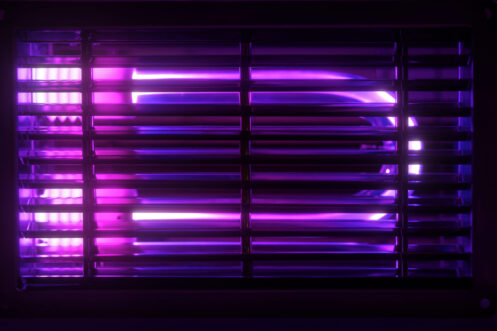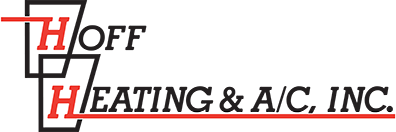Are HVAC UV Lights Safe?

Indoor air quality has become a crucial concern for many homeowners. Many have resorted to using ultraviolet (UV) light together with their HVAC systems to ensure their air is clean. However, as this technology becomes accepted, there are also health risks due to improper installation and maintenance of UV lights.
The question that everyone is asking is, are HVAC UV lights safe? UV lights can be used for air disinfection; nevertheless, the right usage and safety measures are necessary. Read on to find out more.
UV Lights in HVAC Systems
UV light has been used in applications such as water treatment for many years because of its short wavelength radiation between 200-280 nm. It is very destructive to the nucleic acids of microbes, thus preventing their replication. UV lights are often found in the ductwork of an HVAC system before the air handler. The circulating, conditioned air is exposed to the UV light, which then attacks any airborne pathogens by breaking down their DNA or RNA, thus making them inactive. Some HVAC UV light systems also incorporate ionization to eliminate odors and statically charged particles in order to be filtered downstream.
The UV lights need to be always on so that they can perform their function; the bulbs lose their effectiveness over time and hence need to be changed at least yearly. This UV light will cause some HVAC components to start degrading in just a few years, so they become ineffective. The common problem of contamination in the HVAC unit must not be overlooked at all. This is an aggravating factor for building-related diseases.
For homeowners seeking extra air purification and disinfection beyond standard filters, UV lights integrated into their central HVAC system can be appealing. It enables the continuous treatment of recirculated indoor air without requiring extra floor units or standalone purification devices. Manufacturers claim that UV lights can eliminate up to 99% of airborne viruses and bacteria as well as control mold and odors. UV lights, as a passive and automated technology, are becoming more popular than manual HVAC cleaning or occasionally replacing standalone filters.
Potential Health Risks of UV Lights
While ultraviolet light is highly effective in air disinfection, overexposure to ultraviolet radiation can also harm humans if not controlled. The main dangers from UV light are burns and damage to the skin and eyes. Over time, excessive exposure to UV light has also been associated with the development of skin cancer.
The risk depends on several factors, such as the wattage or intensity of the UV bulbs, the wavelength of UV light emitted, distance from the light source, and the duration of exposure. Higher-wattage bulbs, UVC light below 280 nm, and closer contact all increase the risk. According to the Centers for Disease Control and Prevention (CDC), any direct exposure and reflection of UV light should be prevented, especially for occupationally exposed HVAC technicians during maintenance and bulb changes.
However, most experts assert that with properly shielded UV lights installed at recommended distances in HVAC systems, the health risk to occupants is very low. Standard residential HVAC ductwork provides some natural shielding, and manufacturers will specify safe installation clearances of 6-12 inches from air streams. Some newer, intelligent UV light systems also automatically shut off power to bulbs if shielding is improperly installed or removed for maintenance.
Effectiveness Against Pathogens
While UV lights pose potential low risks, research has demonstrated their effectiveness at controlling pathogens when properly applied. Many peer-reviewed studies testing UV light installed in an HVAC system find that it reduces viral concentrations by over 99% and bacterial counts by 97% compared to non-UV-treated areas. Research also shows UV lights achieving 3-5 log reductions of common viruses and destroying up to 97% of mold spores circulating through ducts.
As a passive technology, UV lights’ continuous disinfection of recirculated air offers advantages over manual cleaning methods or occasional filter replacements. However, factors like air velocity, bulb ageing, and fouling of reflective enclosures can impact their long-term performance, making proper maintenance important. When installed and operated under the right conditions, UV lights integrated into HVAC systems have proven potent at neutralizing airborne threats.
Safety Standards and Recommendations
To ensure the safe application of UV lights, organizations like the CDC and FDA have issued guidance on recommended design criteria. Their general performance standards include:
- Wavelength output restricted to UVC between 200-280 nm
- Intensity levels not exceeding 30mW/cm2 at minimum bulb lifetime
- Proper shielding of bulbs to prevent direct exposure and reflection
- Installation clearances ranging from 6-12 inches from air streams
- Interlocks designed to turn off or interrupt power supply during maintenance
Following these national safety standards, HVAC equipment manufacturers will provide their guidelines specifying approved bulb types and the wattages, initial setup clearances, and service/replacement procedures. They may also recommend additional checks of reflective enclosures and airflow optimization. With proper compliance with manufacturer specifications and adherence to general safety guidelines for ongoing use and maintenance, most experts agree the risk of UV lights is quite low.
Weighing the Risks and Benefits
While extended exposure to unshielded high-intensity UV light certainly poses risks, evidence indicates that with responsible installation and upkeep of current HVAC-based UV light systems, they can be safely operated in occupied residential spaces. Key factors that help ensure safety include:
- Using lower-wattage bulbs (5-30 watts)
- Installing lights at recommended distances
- Routinely checking reflective shields and air velocities
- Replacing bulbs per the manufacturer’s schedule
When balanced with preventative maintenance and operational supervision, the microbial reduction benefits of integrated UV lights arguably outweigh the minimal risks, given proper safeguards are followed. Their automation provides a passive yet powerful solution for sanitizing HVAC systems against various airborne pathogens. With growing importance placed on indoor air quality, UV lights are likely to remain an attractive supplement to traditional filtration methods.
While UV lights effectively kill viruses, bacteria, mold and more circulating within HVAC systems, ensuring they are properly installed and safely operated according to the standards is paramount. When used correctly through adherence to manufacturer specifications and general safety guidelines, UV lights integrated into residential HVAC systems can be a viable air disinfection technology with health risks kept to a minimum.
As with any environmental alteration, education and preventative steps are necessary to balance the pros and cons of emerging indoor air purification methods like UV lights. By accepting their benefits and monitoring ongoing safe usage, homeowners can make informed decisions around utilizing this innovative clean air technology.
For over 35 years, Hoff Heating & AC has been committed to providing residents in the O’Fallon, MO area with comfortable and energy-efficient indoor environments. As a leading Lennox Premier Dealer, we can assist you with heating, cooling or indoor air quality needs, including UV light installation and service. Our NATE-certified technicians are fully trained on the latest HVAC products and technologies. We will carefully evaluate each unique home system to design the optimal customized solution. Contact Hoff Heating & AC today to schedule an in-home consultation and air quality inspection.

